By Pete Vack
Photos from Alfa Brochures
The Alfetta Sedan and GT
The Alfetta series—which are roughly defined herein as any of the front engined, de Dion transaxle cars made from 1973 to 1992, were created to replace the existing solid axle Alfas, and to significantly improve the highly praised handling characteristics of the Alfas produced up to that point.
The Alfetta took its name from the famous 158/159 Alfa Romeo Grand Prix cars, raced from 1939 to 1951. These unbeatable race cars featured a similar transaxle layout, and were called the small Alfa, or Alfetta, because of the 1500cc displacement. However, a major difference was that the Grand Prix car left the clutch at the engine end, a difference that as we shall see, meant a great deal. All in all, the Grand Prix car was one of the most successful and perfect front engined Grand Prix cars ever constructed; the Alfetta series was not, and the name as applied to the production car didn’t last long. which was probably a good thing.
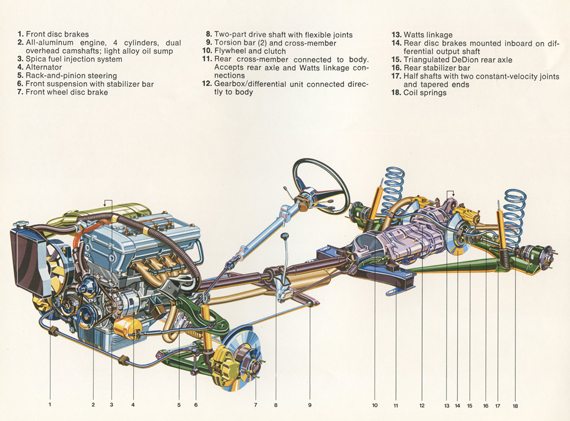
A fantastic idea in concept, but keeping that long driveshaft vibration free as it turned at engine speed was difficult to achieve. However, the 50-50 weight distribution made the Alfettas and their successors a joy to drive.
Still, we had hope. The Alfetta was conceived under the technical direction of Rudolph Hruska, who had been recalled by Alfa to replace the great Dr. Orazio Satta Puliga. In every way, the conception, the idea, the dream of the new Alfetta was thoroughly commendable, and held great promise.
On paper, there was little to fault. Here was a car with the traditional 2 liter four, (2000 cc for the US market, and available in both 1.8 and 1.6 versions in Europe) now producing about 140 hp, with a completely new chassis with torsion bars instead of coils up front, a de Dion rear axle with a inboard disc brakes and the clutch integral with the transmission. The combination meant a 50-50 weight distribution, less unsprung weight, no axle tramp, and excellent handling characteristics for both road and track.
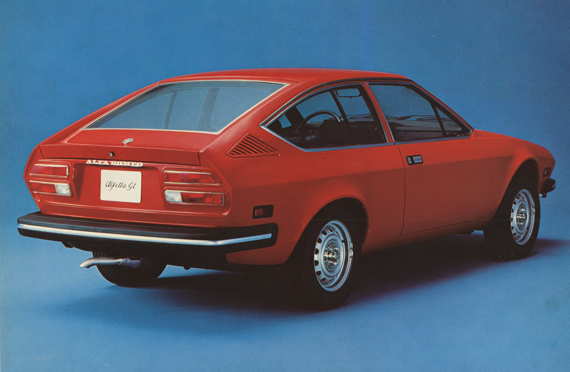
The Alfetta GT by Giugiaro was a worthy successor to the Bertone GTV and as fresh today as it was in 1974.
The in-house designed Alfetta 1.8 sedan, first seen in May of 1972, was a refreshing change from the previous and bulky 2000 Berlina, with modern instrumentation, plenty of greenhouse, and more interior room despite a shorter wheelbase. It was truly a sedan that could handle, and accommodate five people with both ease and comfort. Even with the 1800 cc version, performance was more than adequate, and at the time, one of the hottest sedans on the market.
But that was nothing compared to the Alfetta GT 1.8, which was designed by Giugiario and introduced to the press in June 1974. The design has held and today it is as attractive as it was in the early 1970s. Plus the Cd factor was an excellent 0.39. It was a successful attempt to replace the classic Bertone Sprint coupe, a very mean feat. The interior could be described as ultra modern, and Alfa placed the tachometer directly in front of the driver, with the speedometer in the center, a purposeful snub to the new US 55 mph speed limit. The Alfetta GT had charm, engineering, beauty and class.
Nevertheless, the attempt to maintain a reliable and vibration free drivetrain was valiant but to a large degree, in vain. In the mid 1960s, starting with the 275GTB, Ferrari also decided to place the clutch and transmission with the rear axle. Despite a lot of development time, superb quality and engineering, the problems associated with the driveshaft turning at engine speed were never fully resolved, despite the use of an enclosed torque tube and eventually, a full integrated solid drivetrain from stem to stern. Years later, however, Ferrari tried it again with the 456 GT, which also used a transaxle layout and enhanced for the 612 Scaglietti.
That Alfa would be able to solve the same problems on a mass production basis was unlikely. During the development stage, the prototypes had constant vibration maladies, in addition to headaches with the long distance gearchange, delaying the introduction of the Alfetta by almost a year. However, according to a reliable source at Alfa, “By design the shift throw was not to everyones’ liking and was never intended to be a rock-crusher Hurst-type box and linkage…but the design execution worked extremely smoothly in regular use by careful drivers. The shifting of the 1975 model was superb and only improved somewhat by the redesign of the center rubber u-joint in 1976 and ultimately with the 1985 isostatic shift mechanism installed in production on 1985-1986 GTV-6’s. With the new u-joint in production the complaints directed to Alfa Romeo Owner Relations essentially disappeared.” Even though most of the problems with the gearshift linkage were resolved, gone was the golden wand of the earlier five speed cars, which the gearlever directly attached to the transmission. This was much lamentable.
The first production Alfettas lacked the quality of previous Alfas. Seats became unstitched, fragile switches often broke, dash pods and glove boxes warped in the noonday sun. Where body rust had once been limited to wheelarches and rockers, after a few years it now appeared around the front and rear windows, the front shock mounts, the edge of the fenders, and other gruesome places one never bothered to look.
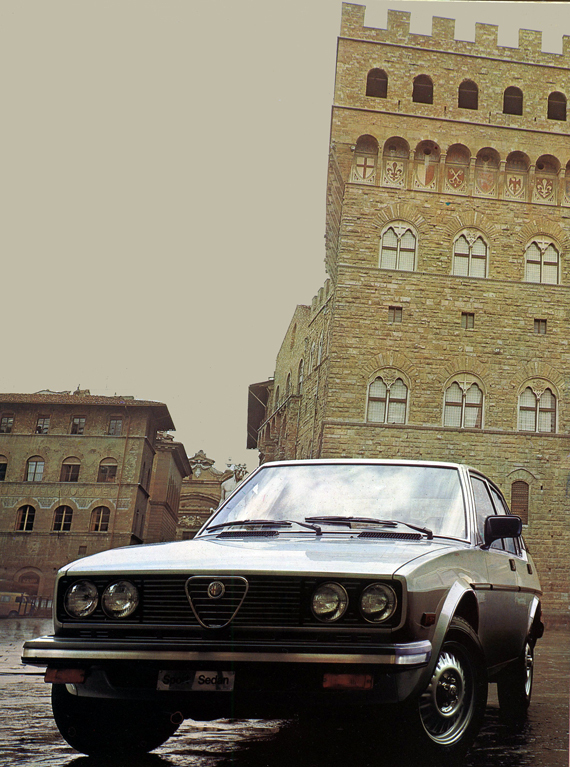
The Sport Sedan of the same vintage (exact year unknown). It would be the first Alfa with an automatic transmission.
Two other foibles affected Alfas of the period…a tendency for the oil passage crank plugs to fall out causing a reduction in oil pressure, and the discovery of the pop rivet. Said our reliable source, who had access to all the warranty claims, “Hundreds of pop-rivets were used in production of the Alfetta body…a foreshadowing of the heavy use and reliance on today’s high value Audi and Jaguar aluminum chassis structures for example…not to mention the hundreds of such rivets used on new 2015 model 150 Ford aluminum truck. Some people criticized the production technique at the time but the Alfetta unibody remained a tough, strong, rigid and rattle-free execution to this every day.”
With each model, the cars were improved in every respect. Commented our ex-Alfa employee, “Some of the improvements in the Alfetta series came through the use and installation of high grade German components from Bosch, for example, and in the case of the 1978 Sport Sedan a new and bulletproof ZF three speed transmission. Overall, the Alfetta 116 series suffered no higher a number of warrantable defects than its European contemporaries did.. each of those had their own unique set of defects and anomalies…some of a vastly more alarming character.”
Ironically, as the cars got better, the Alfetta name was dropped. Consumers in the US knew nothing of the Alfetta 158/159s, and in Europe, Alfetta meant ‘small’ Alfa, which was not a positive term. The world was changing, and in 1986, Alfa even offered (and pushed) the first automatic transmission in an Alfa Romeo, on the Sport Sedan, primarily because it made for a much smoother, long lasting drivetrain.
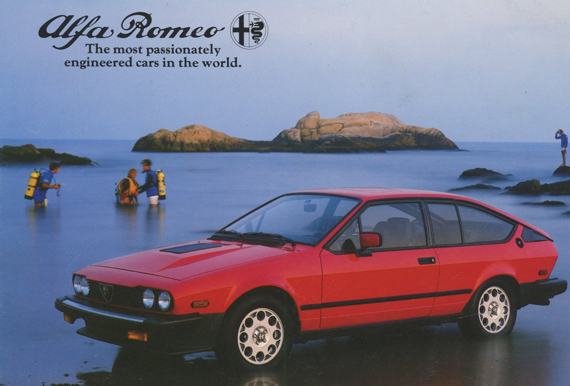
last of the line. In 1985 GTV6 was priced at $13495 and carried a 3 yr/36000 mile warranty. The Alfetta's drivetrain would get one more go in the Alfa Milano/75.
Alfa had another trick for the ailing Alfetta GT, and that was to install the new V-6. This made a totally different animal out of the Giugiaro coupe, and led to the Alfa 75, aka Milano in the U.S. By the time the Milano was introduced in late 1986, it was hard to tell that the car had a driveshaft turning at engine speed, and the quality was further improved. It seemed as though Alfa had finally gotten its act together. But the Milano and its smaller European counterpart the Giulietta, would truly be the last of the real Alfa Romeos; front wheel drive would now prevail at an Alfa Romeo now owned by Fiat.
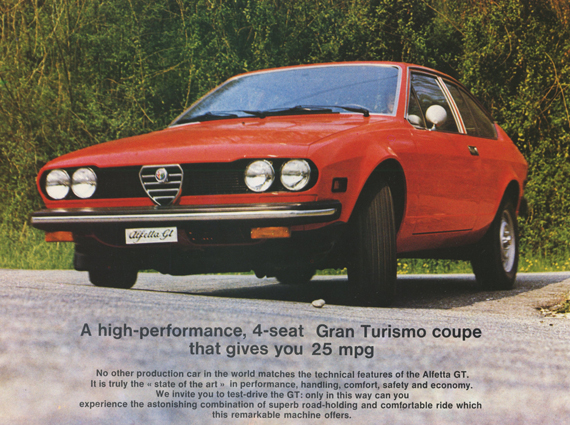
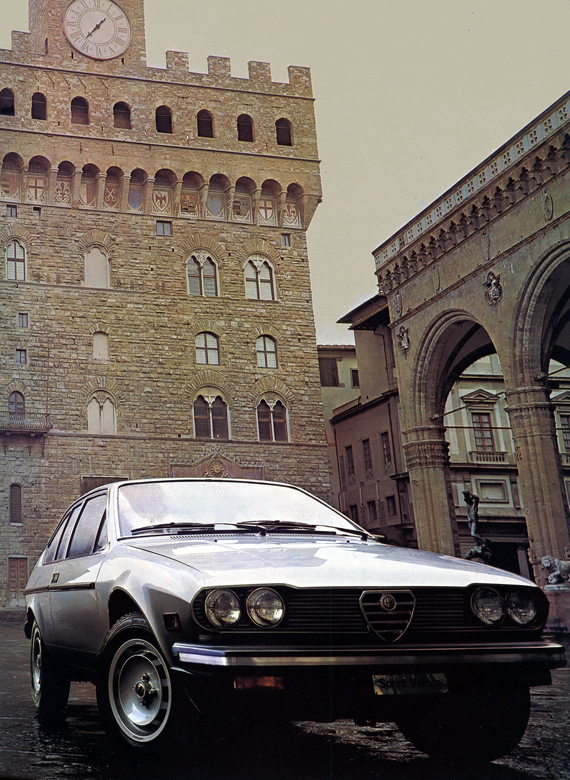
I had a GTV-6 as my daily driver for almost ten years, and as the article states most of the bugs were eliminated. In 80,000 miles of driving I did have to replace the head gaskets twice and it did seem to wear out the inboard brake discs at a higher than normal rate, but it was a great handling car with such a great engine. (Would still have it, if not for corrosion that could not be forstalled.
One small error, in the very last sentence; the last real Alfas (RWD) were the 1989 Milano, and the spider, which would motor on until the Commemmorative Edition,
which ended in 1984. Also a RWD car.
I am one original owner (bought it new in 1980) of a 1979 Alfetta or Sprint Veloce, silver color just like that picture. I still have the car in my house. Would you like some pictures that I took some time ago? Sam Fung email: samsfung@yahoo.com
I have had my GTV-6 since 1984, which I bought new. Aside from a problem created by a backfire, resulting in a missed belt tooth and resulting in a bent valve, requiring a rebuild, the car has been a terrific car. the leather upholstery is not the best and most durable, but is still OK. It keeps company with a 1965 FIAT 600-D, with 26k original miles, 13 inch wheels and a counter-rotating, Abarthized 903cc engine, and a 2013 Dodge Dart Aero, with the 2litre Alfa Tigershark engine, (which is great). Glad to see Alfa coming back to the US and look forward to driving a 4-C. Go Alfa.
I had an ’89 Milano Verde that I bought new. It had far fewer problems than the Taurus wagon I bought the next year. It went 110k miles, including track schools and autocrosses, before being totaled. It was one of the best cars I have owned.
Thanks for the piece. Wonderful car to own and drive. I had a ’76 Spica 2.0L Alfetta Berlina that saw me through 5 trouble-free years of college, then a ’76 Spice 2.0L Alfetta GT which suited my sportier side. Now I’m very happy to own a rust-free ’82 GTV6 Balocco… Proving to me that the Busso V6 richly deserves its selection by Classic and Sportscar Magazine as the second best sounding engine in automotive history. Yes, the gear shift is a bit vague, but you learn it’s part of the Alfetta character. No, I never had any vibration issues with any of the three I’ve owned, ever. I’m surprised to read this was a prevalent issue.. Rust, cracking plastic, weak switchgear, yes – some of that, but you learned to treat Alfetta’s with finesse, not brute muscle. Ciao!
Currently rebuilding ’78 Coupe. Fabulous vehicle, keeps company with 3200 GT Maserati. Who supplies headlights with good reflectors? These are last items needed.
Alfa Romeo South Africa in conjunction with Autodelta, produced the Alfa Romeo GTV6 3.0, a limited run of 200 units for homologation during 1984-1986, which enabled the cars to race on SA tracks.
2935 cc V6
128 kW @ 5800 RPM / 171 BHP
222 N.m @ 4300 / 164 lbs-ft
Compression Ratio: 9.0:1
6 x Dell’Orto Carburettors
Curb Weight: 1138 kg / 2509 lb
Thought the Berlina 2.0l prior to the Alfettas was the first auto-boxed Alfa sedan?
Aspiring to an Alfa in my early years was my goal after a few fiats and one Lancia Beta Coupe. when I saw the alfetta in a small picture on the cover of Road and Track I got the fever while still afflicts me to this day. I’ve had 2 in the past which were great and never had any problems with driveshaft vibration in those. After a short flirtation with an Alfa spider I bought a GTV6 new. It was a great car; but to me didn’t have the essence of the 4 cylinder. there was an element of comprise compared to the original. I did put at least 150k miles that were relatively trouble free. 2 years ago I bought a 15k mi 79 Sprint Veloce that was totally original. Unfortunately I ‘ve had the before mentioned driveshaft vibration which is tough to correct. Make sure you mark the driveshaft from flywheel to transaxle to get it back right. It is such a joy to drive and if there is a better handling car I’d like to know. the parts are kind of hard to find though. This is a special car and hopefully as the years go by it will get the recognition it deserves. Thank You for this great and I find accurate representation of this “Last true Alfa!”
Let’s not forget the 35 odd GTV-6 Callaway Twin Turbo versions built in the mid-80’s with Alfa’s blessing. They were shipped from Italy to New Haven, CT for the transformation. To initially test the reliability, Reeves and the boys simply shaved the pistons for a lower compression, slapped on some brutus turbos and extra injectors, cranked up the engine on the dyno to 600 hp and ran it for 24 hours. No other modifications. Teardown showed nothing unusual! So he backed it down to about 250 hp, with tiny IHI turbos closely tied to the hood scooped intercooler producing zero lag and for the mid-80’s it was (and is) a very quick car. They were sold through a few selected Alfa dealers. None other than Dave Hill, was an early customer, and it led to the Callaway Corvette’s.
The only engine (that I know of) that sounds any better was the Matra V12, but hardly a production engine. To most, the Busso V6 was the most musical internal combustion engine ever created. With the Italian love of the opera, it’s only fitting.
Very enjoyable article. Just one quibble. You state: ” It was a successful attempt to replace the classic Bertone Sprint coupe, a very mean feat.” Did you intend to say: “no mean feat” since “mean” signifies “middling” or “average” when typically used in this context?
As Rory-taylor states the earlier 2000 Berlinas could be had with automatic gearboxes. I know of at least one here in Denmark and I’ve seen several for sale down in Europe. And now I’m at it, the 75/Milano was introduced in 1985 not 1986. It was named 75 because of Alfa Romeo’s 75th birthday.
Best regards from a former owner of both 75 3,0 and heavily modified GTV6 3,0 and now owner of also heavily modified Giulia 1,6 Super/2,0.
Jesper,
I was writing from a US perspective, and so the dates may be a bit different. I was not aware of any 2000 with an automatic in the US but there well might have been. Importation requirements and DOT/EPA regs made it difficult to bring in a lot of models in those years and also varied by state!
RainMeister,
Insofar as no mean feat, well, I must admit defeat.
The Editor
I loved this article about a bit of Alpha history. I wished for more insights about the US version of the GTV-6 which preceded the US sedan being called the Milano. To my knowledge, between the years 1980 and 1986, only 4,674 GTV-6’s were made for the US market. I’m still the proud original owner of a 1984, which has the 2.5 liter V6 engine. Believe only 1,050 of these GTV-6’s were made in 1984 for the US market. So there are not a lot of these running around. I’ve even been pulled over by inquisitive policeman wanting to know “what kind of car is this?” Received no ticket, but was advised to slow down. I have to agree with what someone else who commented about the wonderful engine: single overhead cams punched directly on the intake valves, while the exhaust valves were operated by a lifter and rocker-arm setup. This design worked particularly well and created a most glorious exhaust note that makes the driver want to keep the car moving in a lower gear longer than necessary – just to hear the engine sing. That describes me perfectly. (BTW, saw a typo in the article. Suspect that the GTV-6’s production on the isostatic shift mechanism was not between 1885-1986) Regarding miles per gallon, can’t say that I ever tracked this myself, but an article from Autocar at the Motor Industry Research Association claims that under “gentle” driving conditions they obtained 30.2 MPG. That sounds great for a V6 even by today’s standards!
Hi, thanks for the history. I raced a 1976 Alfetta GT at club level for about 18 years until it was written off. For the last 10 years it had a solid tailshaft with CV joints in place of the donuts and a 200hp naturally aspirated 2 litre engine with a lightweight flywheel. This made a racket at idle once the CVs had any wear at all, overcame the high speed vibration but broke several clutch housings and sheared off the clutch input shaft three times because of the pounding. Finally went back to the donuts, with careful alignment and balance they last quite well. The 4 cylinder engine sounds great at high RPM, but has some considerable harmonic vibrations once you get into the 7000 to 8000 RPM area.
The engine itself has been super reliable, tapped grubscrews in place of the crankshaft oilway plugs.
Like Jay Maveety, I also bought a new 1989 Taurus wagon but prior to buying a used 1987 Milano Platinum that I bought used in the spring of 1990. The Taurus was the most problematic car I have ever owned, versus the Milano, which was quite reliable other than the giubo the flew apart early in my ownership while enjoying the sounds of the engine. After being hit twice within a couple of months in the rear, I ended up selling it. It was one of the most enjoyable cars that I ever owned.
Only a few blocks from my house in Windosr, Ontario an Alfa Sports sedan is sitting forlorn with a smashed driver’s side window and rusty panel in front of the wind shield. I have been told the owner wants a $ 1000 for it. I own a blue 1969 GT Junior 1300. Adrian
I had a ’78 GTV, bought in 1981. Man, I loved that car, warts and all. The first gear synchro was already shot by the time I bought it, so I was in the habit of pulling the stick into second for a moment before notching it into first. The Spica fuel injection was fiddly, and costly to have the dealer set it up, at least for a guy just starting out on his first real job. But once everything was dialed in, it was a terrific driver. A friend of mine had a new Porsche 944 and we’d swap cars periodically. His had more power, but the Alfa gave up nothing in the way of handling and was overall a much sweeter drive. And what a sound! Mine did not have air conditioning, which was a good thing. The others I’ve driven with AC were noticeably slower. I never had a problem with vibration, although I had to have the donuts replaced when one broke. Ultimately, it was the onset of rust that made me sell it before it became a bigger (that is, more expensive) problem than I’d be able to fix. A year or so after I sold it, I happened upon it parked at a gas station, long out of commission, looking forlorn. Sad.
One thing I should mention — these Alfas were very advanced for their day with a collapsible body structure. The dealer took me back behind his showroom and pointed to his own GTV, totaled. He had been sitting at a stoplight and was hit from behind by a drunk driver at high speed. The rear of the car was compressed like an accordion, but from the middle of the car forward, it was perfect. He walked away with no more than a bloody lip.
I own two, a 1986 GTV6 that I’ve driven for 28 years. I still absolutely love to drive this car especially with some incremental performance upgrades over the years. It runs stronger after a full day of hard driving. Never had a drive shaft problem, replaced the guibos but had the shaft re-installed without an issue. The other is a rust-free, now 60k mile 79 Alfetta Sprint Veloce, its also a joy. The power from the 2 ltr twin cam 4 is remarkable, the lighter character of the car a great contrast to the V6 car. The red paint and chrome or bright stainless is now a classic look that draws attention. I had the drive shaft guibos replaced, the shaft computer balanced, smooth as can be. BTW the two photos of the silver sedan and coupe are from a 79 sales brochure that I own. Thanks for the great article on these beautifully engineered cars.